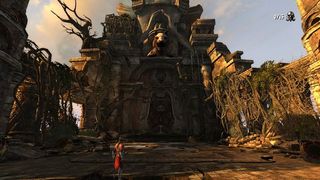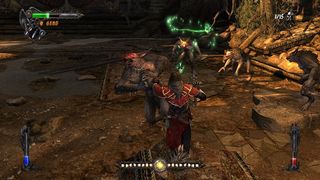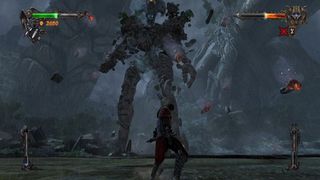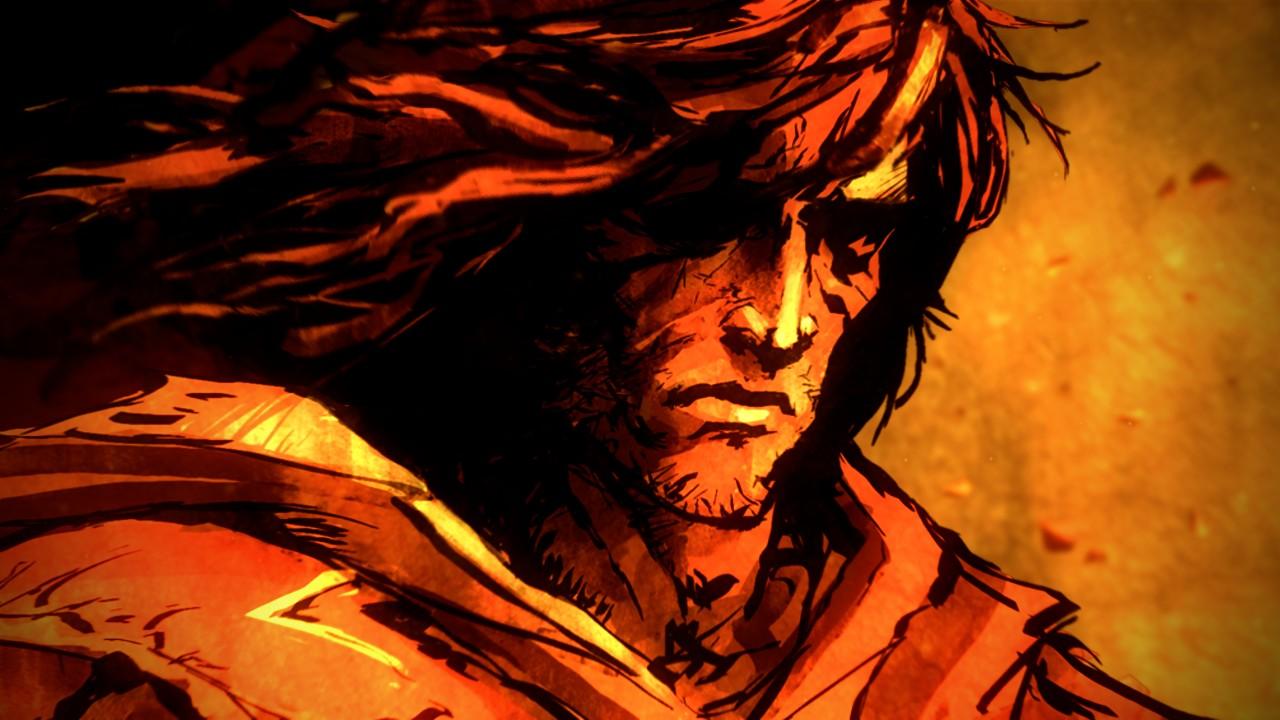Why you can trust 12DOVE
So we’ve talked about how LoS is a reboot, how it’s hardcore, and how it shakily fits into the series. Let’s get into the details of how it plays, which makes other questions fade into the background since it’s so damn solid at its core. First matter of importance is the perspective. Castlevania has done three-dimensional movement before, but LoS does it with confidence. There is no camera control – the right stick sits inert and unused, and it takes getting used to, but we were amazed at how well the fixed camera has been designed. It’s obvious that every single camera angle through the entire game has been placed carefully and tested. There were a few moments where it annoyed us, like when we entered an intersection of pathways and the camera angle switched so that it was hard to tell what direction we came from, but for the most part it’s possibly the most intelligent uncontrolled camera we’ve ever seen. See an area that looks juicy for exploration, but it’s obscured by a pillar? Just walk over there and almost invariably the camera will cut to a new angle letting you know that no, there’s no hidden treasure there to nag your collection-hungry unconscious.

Above: The camera adjusts for all kinds of breathtaking angles. It trades a small amount of useability for striking visual compositions, and we think the tradeoff is worth it
Gabriel himself controls with tight responsiveness. Jumps, swings, and dodges all provide nimble precision. The main weapon, the combat cross, is a cross (duh) that somehow hides a fifty-foot chain inside of it. Most attacks feel straight out of God of War, although with attack buttons divided between direct and area attacks instead of light and heavy, attack choices feel even more under your control – you know that at any given time you can pepper a combo with alternate directional focus. So for instance, you can be pummeling a single foe for a few blows, but when other enemies close in around you, throw in some area attacks to suddenly shift from laser-precise slashes to big overhead helicopter swings. A particularly interesting design flow is that for us, the first half of the game rarely required area attacks. At first we were disappointed that an entire attack button felt redundant, but then in the later game the enemies really swarm in and suddenly combat seemed to open up and expand in its variety.

Above: We prefer to deal with werewolves by grabbing the motherf---ers by the throats. Also, throwing naked fairies at them (the green sparkly thing)
The combat cross gets upgrades, but these are almost exclusively for non-combat moments, allowing you to access areas by using the cross as a lever or grappling hook. Gabriel’s other weapons, of which there are only four, offer combat options which will make or break the difficulty of the game for players. Not learning how to use them, when to use them, or forgetting to use them all will make the game far more difficult. First Gabriel gets the daggers. More than simply a ranged attack, they’re a counter to specific enemies. Being made of silver, they have a lovely property of making lesser werewolves explode like blood-filled balloons with a single hit. Then there are fairies (yes, fairies). A fairy will home in on an enemy and harass it, effectively stunning it.
There’s a crystal secondary weapon which when broken summons a demon displaying some of the least sexy nudity in gaming, and is your typical room-clearing bomb, designed to save your ass in a bad situation or to severely damage a boss. And finally there’s holy water, Castlevania’s version of the grenade. Each of the four weapons is strong against certain enemies and weak against others, and unfortunately the game does a very poor job of explaining this. Every enemy has a description in the pause menu that lays out a grid explaining what weapons work best against them – we had to deduce the meaning of this, but next to each weapon will be one to three skulls indicating how weak they are to that weapon, or one to three shields, denoting resistance. Pausing to check these statistics will greatly reduce frustration.

Above: The titans require their own special approach. This one is tough until you learn the patterns
While the secondary weapons may seem basic, they can also be enhanced by magic. It’s the magic system that really sets LoS apart, making its combat a fresh experience.
It%26rsquo;s all about resource management
This may sound weird in an action game, or even unappealing, but let us explain what we mean. Where most games these days provide health packs or the overused regenerating health, Gabriel has almost no means to heal himself other than attacking with Light Magic (exception: sparsely-placed health fountains). But before we get into exactly what Light Magic does, let’s talk about the magic system in general.
Partway into the game, Gabriel attains the ability to use magic. First, it’s just Light Magic, and then a bit later, Shadow Magic. This is not magic in the typical sense of casting spells. The magic is used purely to enhance or alter the way Gabriel’s attacks work. Hitting one of the shoulder buttons activates magic, swathing Gabriel in blue flames (Light Magic) or red flames (Shadow Magic). Once magic is active, it adds properties to combat cross attacks and secondary weapons. Light Magic heals a small amount of life for every whip strike. Shadow Magic increases the damage that the combat cross does. Only one type of magic can be active.

Above: Yawn, another beatutiful vista. We're busy monitoring our health (upper left), Light Magic (lower left), Shadow Magic (lower right) and Focus meter (lower center)
So using magic properly is a minigame of resource management. An example of combat would be starting off with some Shadow Magic to deal extra damage initially, but after Gabriel takes some damage, switching to Light Magic to replenish health (and watching the health bar to make sure to switch off Light Magic as soon as health is full, since the healing properties are wasted then). Healing yourself becomes an interesting mechanic – topping off health now and then with a few cracks of the whip. In addition to the enhanced normal attacks, magic also changes how secondary weapons work. Daggers become more powerful with Shadow Magic – and sometimes extra powerful against certain enemies. Fairies become homing bombs with Light Magic, first distracting an enemy and then exploding. Holy water, when enhanced with Light Magic, gets tossed at Gabriel’s feet and activates a temporary shield around him.
Killing enemies produces Neutral Orbs – Gabriel’s magic source. Neutral is the important word there, because these orbs can refill either the Light or Shadow meters – it’s your choice with a click of either the left or right sticks. You can even click both sticks and absorb equal amounts of Light and Shadow. Yet it gets crazier: landing a killing blow on an enemy while either magic is active means you get no orbs. You have to use magic in bursts, cutting it off before the killing blow to maximize orb production.
Wait, wait – we’re not done with the awesome meta-combat system. Later on in the game Gabriel gets the Focus meter. Now, landing hits on enemies builds this meter,but the meter drains out if you don’t attack constantly. Yet, to increase tactical play, button mashing is the least effective method – varying attacks, blocking and dodging all increase the meter faster. Once the meter gets full, EVERY hit you land on enemies produces Neutral Orbs. Yet activating magic “pauses” the meter, again forcing smart usage of magic. We were not so great at building the Focus meter, but for hardcore players it will be a smooth engine of badassery – activating magic as needed, turning it off to build the focus meter, raking in the orbs when the meter is full, and then abusing magic like crazy.

Above: Sometimes magic is needed for a special circumstance. These giant spiders will poison you, so to cure yourself you have to activate Light Magic and get a hit in. The nice thing? Eventually you get to ride these spiders
It’s quite a few hours into the game before Gabriel gets the Focus meter, so the depth of the combat doesn’t reveal itself right away. Dismissive players will just play the beginning and say, “Oh this is just God of War,” and they’d be right for the most part initially. Managing the two magic meters and the Focus meter makes LoS’s otherwise uninspired combat into something original and truly sublime. Even the lowliest of enemies in LoS are goddamned powerful, but the game lets you use your brain to overpower them if your blocking and dodging aren’t perfect.
More info
| Genre | Action |
| Description | Castlevania: Lords of Shadow reinvigorates the franchise by borrowing from other games, adding its own wonderful magic system, and ratcheting up the epic factor to ludicrous degrees. It’s huge in scope, length, and depth, and it’s polished with obvious love and passion. |
| Franchise name | Castlevania |
| UK franchise name | Castlevania |
| Platform | "PS3","Xbox 360" |
| US censor rating | "Mature","Mature" |
| UK censor rating | "18+","18+" |
| Release date | 1 January 1970 (US), 1 January 1970 (UK) |
South of Midnight's gothic folk tale could be Xbox's ace up the sleeve for 2025

Nintendo Switch 2 could be more like the Wii U than you realize, and I'd say that's a good thing
9 years after Apple helped create our Bluetooth nightmare, Nintendo Switch 2 is sticking with a real headphone jack and I couldn't be happier
Most Popular

